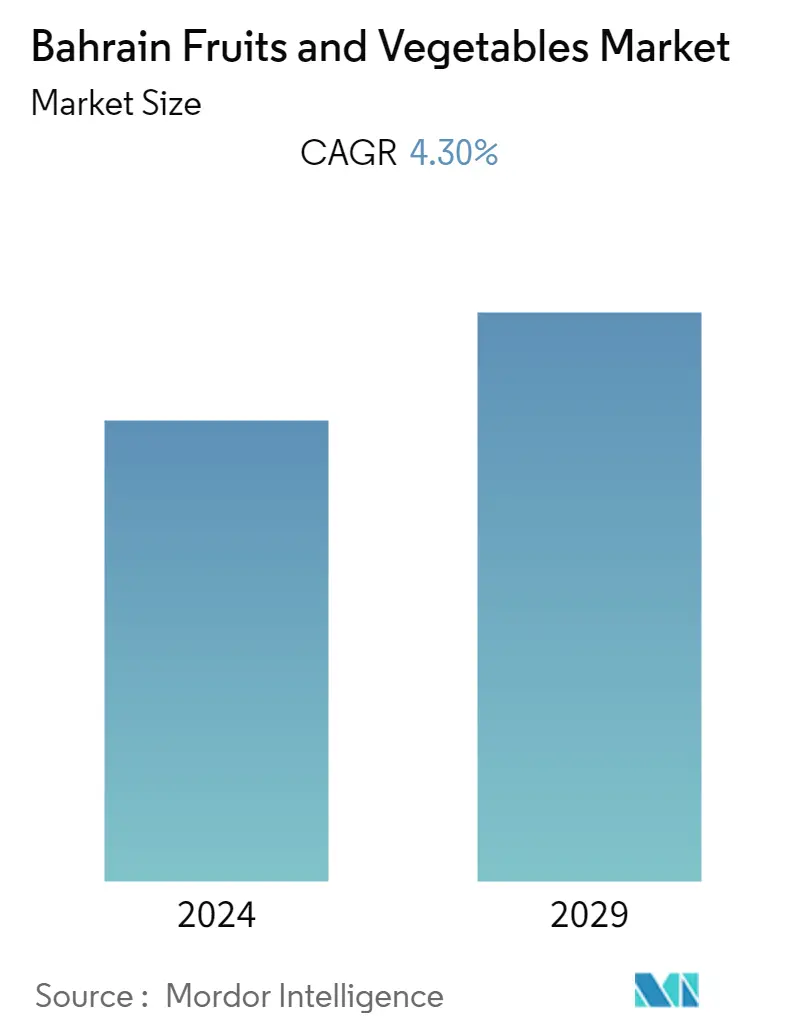Market Size of Bahrain Fruits & Vegetables Industry

| Study Period | 2019 - 2029 |
| Base Year For Estimation | 2023 |
| Forecast Data Period | 2024 - 2029 |
| Historical Data Period | 2019 - 2022 |
| CAGR | 4.30 % |
Major Players*Disclaimer: Major Players sorted in no particular order |
Bahrain Fruits and Vegetables Market Analysis
The Bahrain fruits and vegetables market is projected to register a CAGR of 4.3% during the forecast period.
- Bahrain is characterized by high temperatures, limited arable land, water scarcity, and increasing groundwater salinity resulting in limited crops grown in the country. The national government is focusing on intensifying the finance for agriculture to attract foreign investments for agriculture projects to keep up with local demand.
- The major crops grown are dates, figs, mangos, pomegranates, melons, papayas, water turnips, potatoes, and tomatoes. Dates were the primary domestic fruit crop produced in Bahrain. The production increased from 13.8 thousand metric tons in 2020 to 14.1 thousand tons by 2021. Vegetables are the most important cash crop; 80% of vegetables are grown during winter. Tomato is the most important vegetable; other vegetables are cucumber, lettuce, okra, and onion.
- The increased production of fruits and vegetables in Bahrain has been paired with improved agricultural techniques, especially the adoption of hydroponics and infrastructure linking farmers with urban populations. Vegetables are produced in the open field and under controlled conditions, such as polytunnels and greenhouses. Greenhouse cultivation is particularly common for crops like tomatoes, cucumbers, and eggplants.
Bahrain Fruits and Vegetables Industry Segmentation
Fruits and vegetables are important supplements to the human diet as they provide the essential nutrients required for maintaining health. Bahrain is one of the largest producers of fruits and vegetables in the world, and it produces several horticultural crops, namely apple, banana, orange, pomegranate, guava, dates, tomato, potato, onion, chili, ginger, garlic, eggplant, pea, beans, and okra.
Bahrain fruits and vegetables market is segmented by crop type into fruits and vegetables. The market includes production analysis (volume), consumption analysis (value and volume), export analysis (value and volume), import analysis (value and volume), and price trend analysis.
The report offers the market size and forecasts in terms of volume in metric tons and value in USD thousand for all the above segments.
| Crop type (Production Analysis, Consumption Analysis by Value and Volume, Import Analysis by Value and Volume, Export Analysis by Value and Volume, and Price Trend Analysis) | |
| Vegetables | |
| Fruits |
Bahrain Fruits & Vegetables Market Size Summary
The Bahrain fruits and vegetables market is experiencing a steady growth trajectory, driven by strategic government initiatives and advancements in agricultural practices. Despite challenges such as high temperatures, limited arable land, and water scarcity, Bahrain is focusing on attracting foreign investments to bolster its agricultural sector. The country primarily cultivates dates, figs, mangos, pomegranates, and various vegetables, with tomatoes being the most significant cash crop. The adoption of hydroponics and controlled environment agriculture, including greenhouses and polytunnels, has enhanced production capabilities. This has facilitated better connectivity between rural producers and urban consumers, supporting the local demand for fresh produce.
Bahrain's trade dynamics in the Middle Eastern region highlight its role as a net importer of fruits and vegetables, with significant imports from countries like Saudi Arabia and the United Arab Emirates. However, Bahrain also exports certain vegetables, such as tomatoes, to neighboring countries. The country's free-trade agreement with the United States further strengthens its trade relations with the Americas. Despite the reliance on imports to meet domestic consumption, local initiatives and investments by key players aim to boost domestic production. Collaborative efforts, such as those by the National Initiative for Agricultural Development, are focused on enhancing agricultural skills and infrastructure, promoting local produce, and supporting the overall growth of the fruits and vegetables market in Bahrain.
Bahrain Fruits & Vegetables Market Size - Table of Contents
-
1. MARKET DYNAMICS
-
1.1 Market Overview
-
1.2 Market Drivers
-
1.3 Market Restraints
-
-
2. MARKET SEGMENTATION
-
2.1 Crop type (Production Analysis, Consumption Analysis by Value and Volume, Import Analysis by Value and Volume, Export Analysis by Value and Volume, and Price Trend Analysis)
-
2.1.1 Vegetables
-
2.1.2 Fruits
-
-
Bahrain Fruits & Vegetables Market Size FAQs
What is the current Bahrain Fruits & Vegetables Market size?
The Bahrain Fruits & Vegetables Market is projected to register a CAGR of 4.30% during the forecast period (2024-2029)
What years does this Bahrain Fruits & Vegetables Market cover?
The report covers the Bahrain Fruits & Vegetables Market historical market size for years: 2019, 2020, 2021, 2022 and 2023. The report also forecasts the Bahrain Fruits & Vegetables Market size for years: 2024, 2025, 2026, 2027, 2028 and 2029.

